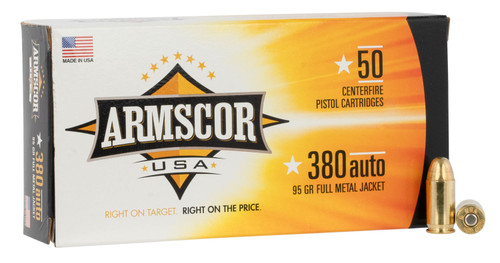.380 Auto Ammo

.380 Auto: In Depth
If you choose to carry a pistol, prevailing wisdom suggests that you carry it often; it should always be there when it’s needed, after all. For many that make the choice to carry, a clothes pocket is the preferred location, and folks have been jamming little guns in their pockets for as long as there have been little guns. If not a pocket, then certainly a boot, ankle holster, fanny pack…handbag? The point is that small guns are made small for concealability’s sake, and once upon a time, small guns were also pretty…pitiful, power-wise.
At the dawn of the 20th century, the FN Model 1905 in .25 ACP and the Colt Model 1903 in .32 ACP were state-of-the-art for semi-auto pocket pistols. While these two (both the pistols and their respective cartridges) were John Browning designs and worthy of respect, they certainly weren’t known for being particularly energetic. Even when using modern defensive loads to benchmark performance, .25 ACP comes in at a whopping 65 ft-lbs, and .32 ACP at 133 ft-lbs.
However, another contemporary Browning design – also small, but mighty – would easily best both of those rounds when it was introduced to the US in 1908: .380 ACP, also known as .380 Auto. This cartridge featured The Colt Pocket Automatic line of pistols, which already featured several models chambered for the two weaker rounds, received a new model to accommodate the .380 Auto cartridge that year. Since .380 Auto was dimensionally similar to .32 ACP, existing pistols could be easily modified to chamber the newer, larger cartridge, which meant that would-be pocket pistol packers often had a choice between at least these two calibers. Importantly, .32 ACP (known as 7.65mm Browning in Europe) generally enjoyed more popularity across the Atlantic than did .380 Auto. Still, both cartridges saw official law enforcement use in Europe, while they were mostly relegated to backup carry for police here in the US.
Pistols chambered in .380 Auto were briefly issued to some US general officers during WWII – you can see a fine example here – but the truth remains: this was not and still is not a cartridge for battle. Longer 9mm Luger and broader .45 ACP have always been more capable as true fighting rounds. The best, or at least the most logical, context for .380 Auto will always be in a small pistol stashed away in a miniature holster, bag, or perhaps – a pocket.
.380 Auto: Guns
Very small semi-automatic pistols have always been the hallmark of this cartridge. Even the earliest Colt Pocket Hammerless pistols chambered in .380 Auto were easy to conceal and lightweight back when they were introduced at the beginning of the 20th century. Nowadays, with advanced polymer technology, pistols can be made even lighter and far more comfortable to carry. Designs like the Ruger LCP and S&W Shield EZ are great examples of lightweight, reliable carry guns if you’re looking for a little less recoil and a higher degree of concealability compared to 9mm Luger options. Additionally, the Shield EZ has the advantage of an easy-to-rack slide, making it especially attractive for those with failing hand strength.
Semi-Auto Pistols
- Ruger LCP
- Walther PPK
- Smith and Wesson M&P Shield EZ
- Glock 28
- Sig Sauer P238
- Kimber Micro
- Bersa Thunder
- Beretta Cheetah
- CZ-83
Why Choose .380 Auto?
If you’re looking to carry a concealed pistol, .380 Auto is a great cartridge choice. Like many handgun rounds, it was greatly helped by advances in bullet technology over the last few decades – specifically, with respect to predictable expansion and penetration in short-barreled carry guns. While most folks will opt for the significantly more powerful 9mm Luger for their concealed carry needs, or perhaps split the difference between the two with the newer .30 Super Carry round, a stoutly loaded .380 Auto is still a fearsome adversary for any would-be attacker.
Self Defense
- Some of the smallest, most concealable semi-autos available are chambered for .380 Auto.
- Muzzle energy is roughly 2/3rds of 9mm Luger, but the round also produces significantly less recoil.
- Modern self-defense loads are bridging the historical capability gap between .380 Auto and 9mm Luger.
Target
- Plenty of FMJ loads are available so you don’t have to train with premium carry ammo.
- European LE-trade-in / surplus pistols are solid, inexpensive plinkers.
.380 Auto: Ammo Brands and Loadings
Hollow point and full metal jacket loads dominate the scene for this cartridge, and most use a bullet that weighs somewhere between 90-gr. and 95-gr. In recent years, more lead-free self-defense options are available with light-for-caliber projectiles – usually 85-gr. and under. Other purpose-built concealed carry loads are around that will expand reliably when fired from a short barrel, so it might be a good idea to pick one of these up if you’re running a micro-compact carry gun. Also, it’s important to note that, even though .380 Auto and 9mm Luger both use the same diameter bullet (.355”) terminal performance is still shy of 9mm Luger, no matter what load you choose. The trade-off is that micro-compact guns in .380 Auto will recoil less than similar guns with 9mm loads, so it’s easier to stay on target when taking shots quickly.
Brands
- CCI, Federal, Winchester, Remington, PPU, Sellier and Bellot, Aguila, Ammo Inc., PMC, Fiocchi, Armscor
Standard Loading
- 95-gr. JHP or FMJ @ 950/fps
Bullet Types
- JHP (Jacketed Hollow Point) - Self-defense
- FMJ (Full Metal Jacket) - Target, training
- HP Lead Free - Self-defense
- Monolithic / Penetrator - Self-defense w/ barrier penetration
- Frangible - Target, training
Bullet Weights
- 56-gr. to 85-gr. - Self-defense (lead free)
- 90-gr. - Self defense / target, light loading
- 95-gr. - Self defense / target, standard loading
- 99-gr. to 102-gr. - Self defense
Velocities
- 56-gr. to 85-gr. - 1,100/fps 1,500/fps
- 90-gr. - 1,000/fps to 1,100/fps
- 95-gr. - 950/fps to 1,000/fps
- 99-gr. to 102-gr. - 815/fps to 1,000/fps
.380 Auto: FAQ
Yes. With today’s premium factory loads and quality firearms, .380 Auto is a great choice for concealed carry. Firearms chambered in .380 Auto are generally smaller, lighter, narrower, and easier to conceal than their 9mm Luger counterparts. Recoil is also less than with 9mm Luger.
If you already own a .380 Auto firearm and want to use it for home defense, go right ahead. However, if you’re shopping for a new firearm for home defense, start with something chambered in 9mm Luger and go up from there. The compact nature of most .380 Auto firearms requires a considerable commitment to practice / training if you want to be a good shot past a few yards.
Yes. Same cartridge. ACP stands for “Automatic Colt Pistol”, and is found in the name of many cartridges designed by John Browning, such as .380 Auto / ACP, .45 Auto / ACP, .32 Auto / ACP, etc.
No. .38 ACP is a semi-rimmed cartridge that predates .380 Auto/.380 ACP by several years, and is also extremely rare. It’s unlikely you’ll ever encounter it.
No. .38 Super was introduced a few decades after .380 Auto/.380 ACP and is also a far larger cartridge. Not the same!











